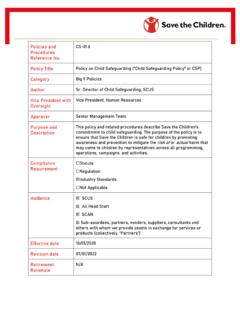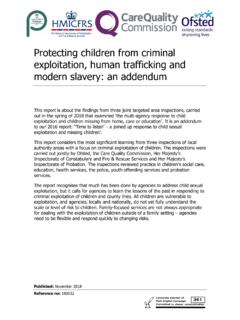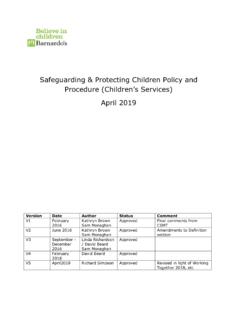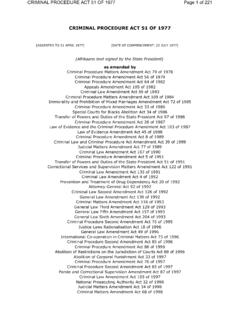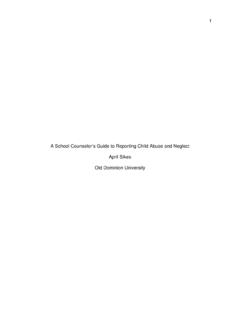Transcription of PROTECTING THE CHILDREN IN SINGAPORE: AN OVERVIEW
1 1 PROTECTION OF CHILDREN IN SINGAPORE: AN OVERVIEW Research and Advocacy Standing Committee Singapore CHILDREN s Society INTRODUCTION Singapore is a small country without natural resources. People are its only resource. Since its independence in 1965, Singapore has enjoyed economic success and this is due primarily to the fundamental principle that Singapore s continued prosperity depends largely on its people to maintain its competitiveness. The Singapore family size is small and its population is ageing. CHILDREN are regarded as valued members of the family and the country s greatest asset and future. As such, great importance is placed on their well-being, health, education and development regardless of their racial, religious and socio-economic background. CHILDREN deserve a childhood free of abuse and neglect and their basic physical, intellectual, emotional and social needs must be met.
2 CHILDREN are vulnerable and unable to protect themselves in adversity. Therefore, they cannot go unprotected. DEFINITION OF THE CHILD The age of majority applicable in Singapore is 21 years old as provided by common law. However, there are different definitions of a child stated in various legislations for specific purpose. According to the CHILDREN and Young Person Act (CYPA) 2001, a child is a person below the age of 14. A young person means a person who is 14 years of age or above but below the age of 16 years. A juvenile means a male or female person who is 7 years of age or above but below the age of 16 years. The Employment Act adopts the same definitions as the CYPA for a child and a young person . The Women s Charter 1997 defines a child as a child of the marriage who is below 21 years , and a minor as a person who is below the age of 21 years and who is not married, or a widower or a widow.
3 Under the Women s Charter, any person who has carnal connection with a girl below the age of 16 years, except by way of marriage, is guilty of an offence. The Penal Code provides that an offence of statutory rape is made out if (among other things) a man has sexual intercourse with a girl even with her consent if she is below 14 years of age. This means that a child below 14 years old cannot legally consent to sexual intercourse. The Smoking (Control of Advertisement and Sale of Tobacco) Act prohibits the sale or giving of tobacco products to persons under 18 years. Under the Custom (Liquor Licensing) Regulations, it is an offence for a licensee to permit a person under the age of 18 to consume alcoholic liquor at the licensed premises or for the person under 18 years to purchase alcoholic liquor. In October 1995, Singapore became signatory to the United Nations Convention on the Rights of the Child (UNCRC), pledging its commitment to help CHILDREN when they are in an environment of abuse and neglect.
4 The UNCRC defines a child as someone below the age of 18. Regardless of how a child is defined, these laws are designed to promote and protect the best interests of the CHILDREN , to punish those who victimise them, and to ensure appropriate treatment for their recovery and social integration. 2 THE SCOPE OF CHILD PROTECTION PROTECTING CHILDREN has to do with the legislation, policies, programmes, and services that strive to promote CHILDREN s holistic development, to protect those who are at risk from harm, and to rehabilitate those CHILDREN if, and when they become a threat to themselves and to others in the society. Although CHILDREN are the primary target, it is important to realise that a child is always part of a system consisting of the family, peer group, school, neighbourhood and the community. What happens within the system would have inevitable impacts on the child.
5 In Singapore, the family is recognised as the building block of society and the most natural environment for nurturing the young. Policies and programmes are therefore pro-family to preserve and strengthen the family unit. Increasingly, many efforts have been made to enable, support and empower the family not only to discharge its responsibilities to the young, but also to enjoy its role. While all families have basic and developmental needs that must be met, some families may face special problems. Poverty, violence, alcohol and substance abuse, and other recurrent and chronic crisis situations in the family may put the child s welfare at risk. Under such circumstances, the state and the community have the responsibility to step in to deal with these problems in the family and to ensure that the child s well-being can be better protected.
6 Child protection services used to deal with CHILDREN when problems occur. The focus in recent years has expanded to become more proactive and preventive in its approach, instead of limiting to treatment and rehabilitation. CHILDREN have basic needs for their healthy growth and development. These include food and nutrition, safety, a nurturing environment, protection from harm, secure emotional ties, and education. They provide CHILDREN with a strong and healthy foundation for life. Services and programmes must therefore promote and support the child s physical, social, emotional and intellectual development, functioning, and well-being. They should also be able to identify CHILDREN and families at risk and to provide early intervention before full-blown problems of a physical, psycho-social, emotional, behavioural, and medical nature emerge. Interventions may involve the removal of a child from a home where he or she is suspected of being abused or neglected to a place of safety, or the removal of an adult responsible for the abuse.
7 For CHILDREN who are already involved in serious antisocial or delinquent activities, such as gangsterism, drug addiction and promiscuous behaviour, intervention and rehabilitation may include institutionalisation for treatment for drug addiction, counselling and vocational training. THE LAW AND CHILD PROTECTION IN SINGAPORE Singapore takes a serious view of violence in any form. The Government believes in creating a violence-free environment and that those who are vulnerable such as the young and those with disability should be protected. Social legislation exists to protect CHILDREN and young persons and victims of violence. Singapore also takes a serious view of child abuse, neglect and sexual exploitation of CHILDREN , as well as the participation of CHILDREN in commercial public entertainment, illegal hawking, gambling and begging. Child protection services firstly aim to ensure the safety of CHILDREN and secondly, strengthen the parent-child relationship.
8 The general legal framework and provisions for the protection of CHILDREN and victims of violence in Singapore are set out in a number of statutes. It is important to note that the law only provides essential safeguards. The more successful we are in our efforts to promote CHILDREN s well-being, the less the law will be called into use. Selected legislations will be highlighted. 3 The CHILDREN and Young Persons Act (CYPA) The CYPA was enacted in 1949 to provide for the welfare, care and protection of CHILDREN and young persons as well as the treatment and rehabilitation of CHILDREN and young persons who are beyond parental control or who have committed offence. The Act strikes a balance between family authority and responsibility and the protection of CHILDREN and young persons by the State. The Act has been amended several times over the years.
9 It was revised in 1993, incorporating enhanced penalties for child abuse. It was further amended in 2001 to widen the options for rehabilitating young offenders. The recent amendments provide greater protection and enhance the well-being of CHILDREN and persons who are neglected, abused or destitute and those who are placed in residential institutions. In the revised CYP Act (2001), emotional and psychological cruelty has been clearly spelt out as a form of abuse. In March 1996, the Child Abuse Protection Team (CAPT) was introduced by the then Ministry of Community Development and Sports (MCDS) to institutionalise a multi-disciplinary and multi-agency team approach in the management of child abuse cases in Singapore. CAPT provides a forum for child protection professionals to discuss, develop and follow through a plan of action for child abuse cases, ensuring that the best interest of the child is being met.
10 The National Standards for Protection of CHILDREN issued by MCDS sets out the framework for the management of child protection in Singapore and describes the referral standards as required by the different sectors involved. The National Standards aims to enable professional judgement to be exercised within a framework of transparency; encourage the adoption of good practice including the development of practice guidelines and manuals; and enhance public confidence that the management of child protection will be prompt and handled with the child s interest as the main priority. MCDS has since become the Ministry of Community Development, Youth and Sports (MCYS). For the abused child and the child at risk of abuse, MCYS has the power to take such cases to the Juvenile Court, which will make a Care and Protection Order (CPO) in respect of the child.
